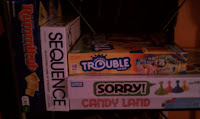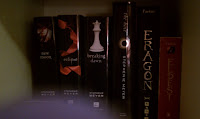- This piece was found on "Graphic Design for the 21st Century"
- Shown as a sample of Phillipe Apeloig's Work
- The content of the advertisement is in direct relation to the image. It is showing an advertisement for a Type contest, and as such the designer actually used the type itself to show the idea of the contest.
- All of the boxes help to create a really great grid structure, as well as create depth within the piece by shearing of portions and sections of words. It allows you eyes to flow across the page and allows continuity to begin to take place to create the rest of the letterforms.
- He was able to really keep in mind that the contest had to appear appealing, without giving away all of the good stuff. Through using continuity and excellent use of color, depth and legibility was created very well.
- The type makes the image descriptive. It allows you to understand the concept of the design contest, but leaves many ideas to the imagination just through creativity and some very basic typography.
Monday, November 15, 2010
Form + Content: Linotype 3rd Design Contest
Thursday, October 21, 2010
Form + Content: Graphic Design for the 21st Century: Peter Anderson in "UltraVision"
- Graphic Design for the 21st Century
- The original piece was made as a poster design to show that language and type shouldn't fall in straight lines, but in an organic system.
- When you look at this piece, you are interested. You want to know how to figure it. So you read it, or try to, and flow around the entire poster. The idea allows you to look away from the grid but to understand that the piece is meant to show the variability of type and language.
- The shape is almost like an amoeba, and I think: wow what a crazy way to show an amoeba made from type! An amoeba is free flowing, it has not definite shape. This makes you look at EVERYTHING, simply because of curiosity and the fact that there is so much to take in.
- This designer thought about the curiosity of their readers. He wanted you to not be able to see the grid, but to see how organic and fun you can make something. He wanted to keep you interested, and used different colors, fonts, and sizes to make the piece an always changing image.
- The type MAKES the image. It makes the viewers see every letter and every word and see those words in the form of the shape.
Friday, October 8, 2010
Form + Content: Kohkoku Magazine
- Mag-Art: Innovation in Magazine Design
- Shown as a spread of examples of a specific magazine's cover.
- Overall, the issue in questions was trying to convey the idea of what "good design" really is. Through not just the cover, but spreads within the magazine, they were able to show what good design LOOKS like, but also what bad design looks like as well.
- It's really interesting looking at the cover they show. The hands holding a piece of paper and pencil and passing it to another person. It makes you think: this is going to tell me how to design something. I want to know what. So I want to pick up this magazine and find out. The next page shows the concept of the content in the magazine. They want to show you what good design is. The man in the image is all happy and presenting a book, or a package; emphasizing: hey, this is important, this is what it looks like and should be. In the final page, you can see where they begin to show you what it looks like. In the phrase it says "the concern is in style, not content"; it makes the reader understand that the design is not about what point the design gets across, but the actual core image or layout itself.
- They really kept the viewers attention, even in a spread form published in another book, by keeping a changing pattern. No two images in the spread were the same. Use of creativity allows the readers to make an assumption of an image and intrique themselves.
- The type was subtle in both the first and second pages shown, and was highly dominant in the last page. It allowed the first two to be more about "lets design according to your imagination", rather than "this is a guide to accurate design techniques." It allowed the reader to understand what the image is supposed to make you see, without spelling it out for you completely.
Thursday, September 23, 2010
Form + Content 2 : Bulb Magazine
- Mag - Art : Innovation in Magazine Design [pg. 065]
- Presented as a small "proof" of a cover of their magazine. Probably a previous issue.
- They way that they use the image to relate to the jumbled concepts of the content of the magazine pulls everything together. It's simple, eye catching, and gets the point across easily.
- The different uses of type, size, color, and placement help pull together the idea of the thought process in the brain. The change of colors helps to draw yours eyes around the page to keep you interested.
- They seem to keep in mind that the design needs to be simple, but not to simple. They used textured fonts to add a special characteristic to the design. They used some form of a grid to keep the text in alternating sized lines, and to keep it flush with the edges.
- Type, in this image, was used to shoed disorderly thoughts, as well as to get the entire idea of the main points of that particular issue across on the cover.
Thursday, September 9, 2010
Form + Content 1: The Bodies Exhibition
- The Exhibit for Bodies is located on 4th and Euclid in Cleveland, OH. I had originally found through another friend who had seen it early this summer.
- The displays are all set up in the form of a typical gallery setting, allowing you to walk around at your leisure and skip around to different parts of the gallery.
- Overall, every piece of work that was in the gallery was scientific, but also art oriented. Each item on display had an explanation of what exactly you were looking at. A cross section of a knee, the developmental process that a fetus goes through in the first two months of conception, the nervous system of a young adult. The basis of the entire exhibit is meant to invigorate your mind but also to inform you of what your body is really like on a scientific level. How everything fits together, how your nervous system works, what smoking can do to your lungs. It really gives you perspective on what you do to your body on a daily basis.
- It was probably the most odd sensation looking at a once living human being, and looking inside of them. Seeing what they look like from the inside out. It created an almost out of body experience for me. Interest seemed like a natural feeling when looking at the exhibit. Everyone is naturally curious, and I think that everyone wants to know how everything works, what it does, what it looks like.
- All of the full sized human "sculptures" were posed. Some playing basketball, some posing, some holding different objects. The designer[s] considered how they could keep the viewer entertained. Also, the way that the displays were made, clean and pristine and basic, helps draw all of the attention to the item that is on display.
- In all of the wall displays there were facts about that specific area of displays. The way that the type was placed on the backdrop of the displays helped to draw your attention the display[s] that the information was connected with.
Subscribe to:
Comments (Atom)










































